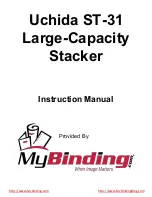
GB
- 115 -
saw if there is no oil in the system or if the oil
drops below the “min” mark. On average, a single
fi
lling will last around 10 minutes depending on
the number of pauses in cutting and the loads
involved.
Saw chain
Tension of the saw chain, condition of the cutting
elements. The sharper the chainsaw, the easier
and more controllable it is to operate the chain-
saw. The same also applies to the chain tension.
Also while working you should check the chain
tension no less than every 10 minutes in order to
increase your safety. New saw chains in particular
often tend to expand more.
Do not touch the saw chain while the device is
switched on. If the saw chain is blocked by an ob-
ject, switch the device o
ff
at once – then remove
the object
– Danger of injury!
Safety clothing
Always wear appropriate tight-
fi
tting safety
clothing like special trousers which protect
against cuts, protective gloves and safety shoes.
Hearing protection and protective goggles.
Wear a protective helmet with integral face and
hearing protection. This will o
ff
er protection
against falling branches and any branches if they
spring back.
Safe working
•
To ensure that you can work in safety you
must use the equipment at a working angle of
max. 60°.
•
Never stand under the branch you want to
saw.
•
Use special caution when working with bran-
ches under tension and splintered wood.
•
Possible risk of injury caused by falling bran-
ches and catapulting pieces of wood.
•
When the equipment is in operation keep
other persons and animals away from the
danger zone.
•
The equipment is not protected from electric
shock through contact with high-voltage
cables. Keep a minimum distance of 10 m
from live cables. Electric shock can cause
fatal injury.
•
When working on slopes always stand to the
upper or left or right side of the branch you
wish to cut.
•
•
Hold the equipment as close as possible to
your body. This will help you to keep your ba-
lance.
Cutting techniques
•
When removing branches, hold the equip-
ment at an angle of max. 60° to the horizontal
to avoid being hit by a falling branch (Fig. 17).
•
Start with the bottom branches on the tree.
This will make it easier for the cut branches to
drop.
CAUTION!
Never stand underneath the branch
you are sawing – always keep out of the range
of falling branches! – Branches landing on the
ground could bounce up again
– Danger of in-
jury
•
After completing a cut, the weight of the saw
will abruptly increase for the operator as the
saw is no longer supported by the branch.
This can result in you losing control over the
saw.
•
Remove the saw from the cut only with the
saw chain still running. This will prevent the
saw from getting jammed.
•
Never cut with the tip of the saw.
•
Never cut into the bulging branch collar. This
will prevent the tree from healing.
Sawing o
ff
smaller branches (Fig. 15):
Place the contact surface of the saw onto the
branch. This will prevent the saw from making
jerky movements when you begin a cut. Exerting
slight pressure, guide the saw from the top to the
bottom through the branch.
Sawing o
ff
larger and longer branches (Fig.
16):
Carry out a relief cut when working on larger
branches.
Start by sawing through 1/3 of the branch diame-
ter
(a)
from the bottom to the top with the top side
of the cutter rail. Then saw towards the
fi
rst cut
(b)
from the top to the bottom with the bottom side of
the cutter rail.
Saw o
ff
longer branches in several steps to keep
control over the impact location.
Anl_PE_EAS_7520_SPK7.indb 115
Anl_PE_EAS_7520_SPK7.indb 115
14.10.14 10:48
14.10.14 10:48










































